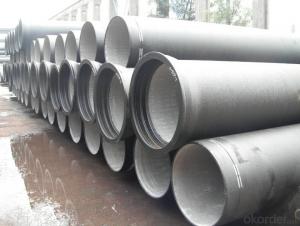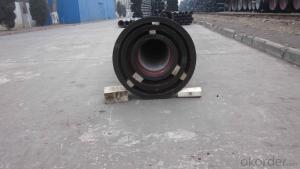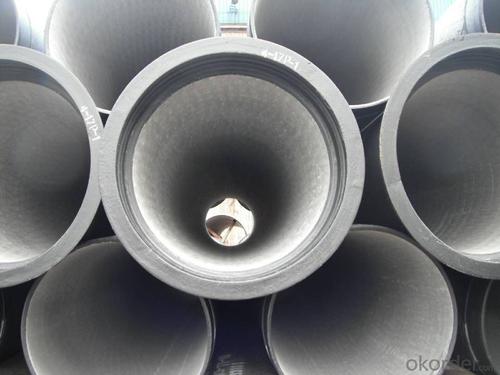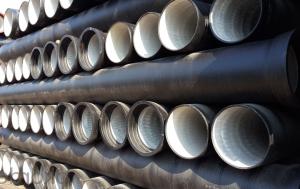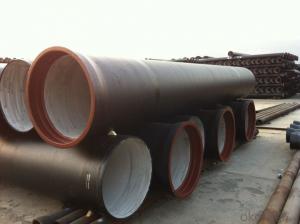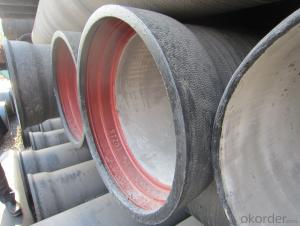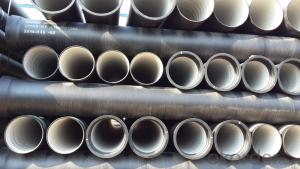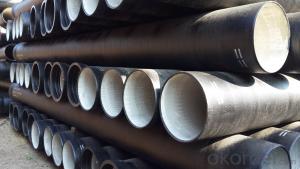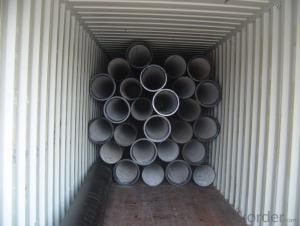DUCTILE IRON PIPE DN100
- Loading Port:
- China Main Port
- Payment Terms:
- TT OR LC
- Min Order Qty:
- -
- Supply Capability:
- -
OKorder Service Pledge
OKorder Financial Service
You Might Also Like
Specification:
1) The standard of pipe: ISO2531:1998, K9
2) Effective length: 6m
3) Inner cement line: Portland cement line as per ISO4179
4) Zinc coating: at least 130g/m2 as per ISO8179
5) Bitumen painting: at least 70um as per ISO8179
6) With 100% quantity of NBR ring, or SBR ring, or EPDM ring as per ISO4633
7) DN80mm-800mm
8) High strength, lighter than grey iron, good corrosion resistance, no furring, small flow resistance, easy fixing, long life tome about 100 yeas
9) Produced by Hangzhou chunfeng machine
10) Checked by automatic inspection equipment
11) Composition:
Chemical composition | |||
Chemical composition | Ductile Cast Iron Pipe (%) | Grey iron pipe (%) | Steel pipe (%) |
C | 3.5-4.0 | 3.2-3.8 | 0.1-0.2 |
Si | 1.9-2.6 | 1.4-2.2 | 0.15-0.4 |
Mn | 0.15-0.45 | 0.4-0.6 | 0.3-0.6 |
P | ≤0.06 | ≤0.3 | 0.02-0.03 |
S | ≤0.02 | ≤0.1 | 0.02-0.03 |
Mg | 0.03-0.06 |
|
|
12) Feature:
Mechanical properties | |||
| Ductile Cast Iron Pipe | Grey Iron Pipe | Steel Pipe |
Tensile Strength(Mpa) | ≥420 | 150-260 | ≥400 |
Yield Strength(Mpa) | ≥300 | No Confirmation | No Confirmation |
Bending Strength(Mpa) | ≥590 | 200-360 | ≥400 |
Elongation (%) | ≥10 | Neglected | ≥18 |
Brinell Hardness(HBS) | ≤230 | ≤230 | About 140 |
13) T type mechanical joint
14) Packing: in bulk or container
- Q: What are the different methods for joining ductile iron pipe?
- There are several methods for joining ductile iron pipe, including mechanical joints, flanged joints, push-on joints, and restrained joints. Mechanical joints use a rubber gasket and a series of bolts and glands to create a secure connection. Flanged joints involve bolting two flanges together with a gasket in between. Push-on joints utilize a rubber gasket and require the pipe to be pushed into the joint. Restrained joints use a combination of mechanical joints and a restraining gland to prevent movement and provide a secure connection.
- Q: Can ductile iron pipes be used in areas with high soil acidity?
- Ductile iron pipes can be used in areas with high soil acidity, but certain precautions should be taken to ensure their longevity and performance. Ductile iron pipes are known for their strength, durability, and resistance to corrosion, which makes them suitable for various soil conditions, including those with high acidity. However, high soil acidity can still pose a potential risk to ductile iron pipes over time. Acidic soils can accelerate the corrosion process, potentially leading to the degradation of the pipe material. To mitigate this risk, several measures can be implemented: 1. Protective Coatings: Applying protective coatings to the outer surface of the ductile iron pipes can provide an extra layer of defense against soil acidity. These coatings, such as epoxy or polyethylene, act as a barrier, preventing direct contact between the pipe and the corrosive soil. 2. pH Adjustment: Adjusting the pH levels of the soil can help reduce its acidity. This can be done by adding lime or other neutralizing agents to the soil, which will help create a more favorable environment for the ductile iron pipes. 3. Cathodic Protection: Implementing cathodic protection systems can be an effective method to prevent corrosion in ductile iron pipes. This technique involves the use of sacrificial anodes or impressed current systems to create a protective electrical current that counteracts the corrosive effects of the soil. 4. Regular Inspections: Periodic inspections should be conducted to monitor the condition of the ductile iron pipes in areas with high soil acidity. This allows for early detection of any corrosion or degradation, enabling timely repairs or replacements to be carried out. By implementing these measures, ductile iron pipes can be effectively used in areas with high soil acidity, ensuring their long-term performance and minimizing the risks associated with corrosive soils. However, it is always recommended to consult with experts or engineers familiar with local soil conditions and the specific requirements of the project to determine the most suitable materials and protective measures.
- Q: What are the typical pressure surge protection measures for ductile iron pipe?
- Some typical pressure surge protection measures for ductile iron pipe include using surge tanks or pressure relief valves, installing air valves or surge anticipation valves, and implementing proper anchoring and support systems to minimize movement and stress on the pipe during pressure surges. Additionally, using flexible joints or expansion joints can help absorb and accommodate sudden changes in pressure.
- Q: Are ductile iron pipes suitable for fire protection systems?
- Yes, ductile iron pipes are suitable for fire protection systems. Ductile iron is a strong and durable material that can withstand high pressure and temperature fluctuations, making it ideal for fire protection systems that require reliable and long-lasting pipes. Additionally, ductile iron has excellent corrosion resistance, which helps to prevent the degradation of the pipes over time, ensuring the integrity of the fire protection system. The high tensile strength of ductile iron also provides added safety benefits as it can withstand the stress and strain that may occur during a fire event. Therefore, ductile iron pipes are a suitable and commonly used material for fire protection systems in various applications, including commercial buildings, industrial facilities, and residential areas.
- Q: What is the average weight of ductile iron pipes?
- The average weight of ductile iron pipes can vary depending on the specific dimensions and specifications of the pipe. However, as a general guideline, ductile iron pipes typically range in weight from around 50 pounds per foot to 200 pounds per foot. The weight of a ductile iron pipe is influenced by factors such as the pipe's diameter, wall thickness, and length. It is important to note that these are average weights, and the actual weight of a specific ductile iron pipe may vary. To determine the exact weight of a ductile iron pipe, it is advisable to refer to the manufacturer's specifications or consult engineering guidelines.
- Q: How do ductile iron pipes perform in extreme weather conditions?
- Ductile iron pipes are known for their exceptional performance in extreme weather conditions. These pipes, which are made from iron alloyed with small amounts of carbon and other elements, exhibit superior strength and resilience, making them highly resistant to the effects of extreme weather. In high temperatures, ductile iron pipes maintain their structural integrity and do not soften or deform like some other materials. This ensures that the pipes continue to function efficiently and reliably, even in scorching heat. Additionally, these pipes have a high resistance to thermal expansion, which minimizes the risk of pipe distortion or joint failure during temperature fluctuations. When it comes to extreme cold, ductile iron pipes also excel. They have a low coefficient of thermal expansion, which means they are less prone to cracking or fracturing due to freezing temperatures. Moreover, their robustness and flexibility allow them to withstand the pressure exerted by freezing water inside the pipes without significant damage. Furthermore, ductile iron pipes exhibit excellent corrosion resistance, whether it be from harsh chemicals, saltwater, or other corrosive substances that may be present in extreme weather conditions. This corrosion resistance ensures the longevity and reliability of the pipes, preventing leaks and maintaining water quality. In terms of durability, ductile iron pipes are designed to withstand heavy loads and external stresses. They have a high tensile strength, making them resistant to bending and breakage. This attribute is crucial in extreme weather conditions where heavy rainfall, strong winds, or even seismic activities may occur. Overall, ductile iron pipes have a proven track record of performing exceptionally well in extreme weather conditions. Their strength, resilience, thermal stability, corrosion resistance, and durability make them a reliable choice for various applications, such as water supply, sewage systems, and industrial pipelines, even in the harshest weather environments.
- Q: How does ductile iron pipe perform in areas with high groundwater contamination?
- Ductile iron pipe is known for its durability and resistance to corrosion, making it a suitable choice for areas with high groundwater contamination. The pipe's protective lining and coating prevent the groundwater from coming into direct contact with the iron, thereby minimizing the risk of corrosion and deterioration. Additionally, ductile iron pipe has the ability to withstand external pressures, making it less susceptible to damage caused by shifting soils or groundwater movement. This characteristic is especially beneficial in areas with high groundwater contamination, as the pipe can maintain its structural integrity and prevent leaks or bursts. Furthermore, ductile iron pipe has a long service life, which reduces the need for frequent replacements and minimizes the potential for groundwater contamination caused by pipe failures. Overall, ductile iron pipe performs exceptionally well in areas with high groundwater contamination, providing a reliable and durable solution for transporting water or wastewater while ensuring the protection of the surrounding environment.
- Q: Are ductile iron pipes resistant to hydrogen sulfide corrosion?
- Yes, ductile iron pipes are resistant to hydrogen sulfide corrosion due to their high resistance to chemical corrosion and their protective inner lining that prevents contact between the pipe material and the corrosive elements.
- Q: What is the expected maintenance for ductile iron pipes?
- The expected maintenance for ductile iron pipes typically includes regular inspections for signs of corrosion or damage, cleaning to remove any sediment or debris buildup, and occasional repair or replacement of sections that are worn or compromised.
- Q: What is the expected corrosion rate of ductile iron pipes?
- Several factors can influence the expected corrosion rate of ductile iron pipes, including the specific environment in which they are installed, the pH and composition of the water or soil they come into contact with, and the presence of any corrosive substances or chemicals. Compared to materials like cast iron or steel, ductile iron pipes are well-known for their excellent resistance to corrosion. This is because they naturally develop a protective layer called a passive film on their surface when exposed to oxygen in the environment. This passive film acts as a barrier, preventing further corrosion. However, it is important to acknowledge that even ductile iron pipes can experience some degree of corrosion over time, especially in aggressive or highly corrosive environments. The expected corrosion rate can vary from very low to moderate, depending on the aforementioned factors. To ensure the durability and performance of ductile iron pipes, it is advisable to follow proper maintenance and monitoring practices. This includes regular inspections, cleaning, and the application of protective coatings or linings when necessary. Furthermore, implementing a cathodic protection system can further enhance the pipes' corrosion resistance. Ultimately, consulting experts and professionals in the field of corrosion and pipe materials is crucial for accurately determining the expected corrosion rate of ductile iron pipes in a specific application or environment.
Send your message to us
DUCTILE IRON PIPE DN100
- Loading Port:
- China Main Port
- Payment Terms:
- TT OR LC
- Min Order Qty:
- -
- Supply Capability:
- -
OKorder Service Pledge
OKorder Financial Service
Similar products
Hot products
Hot Searches
Related keywords

